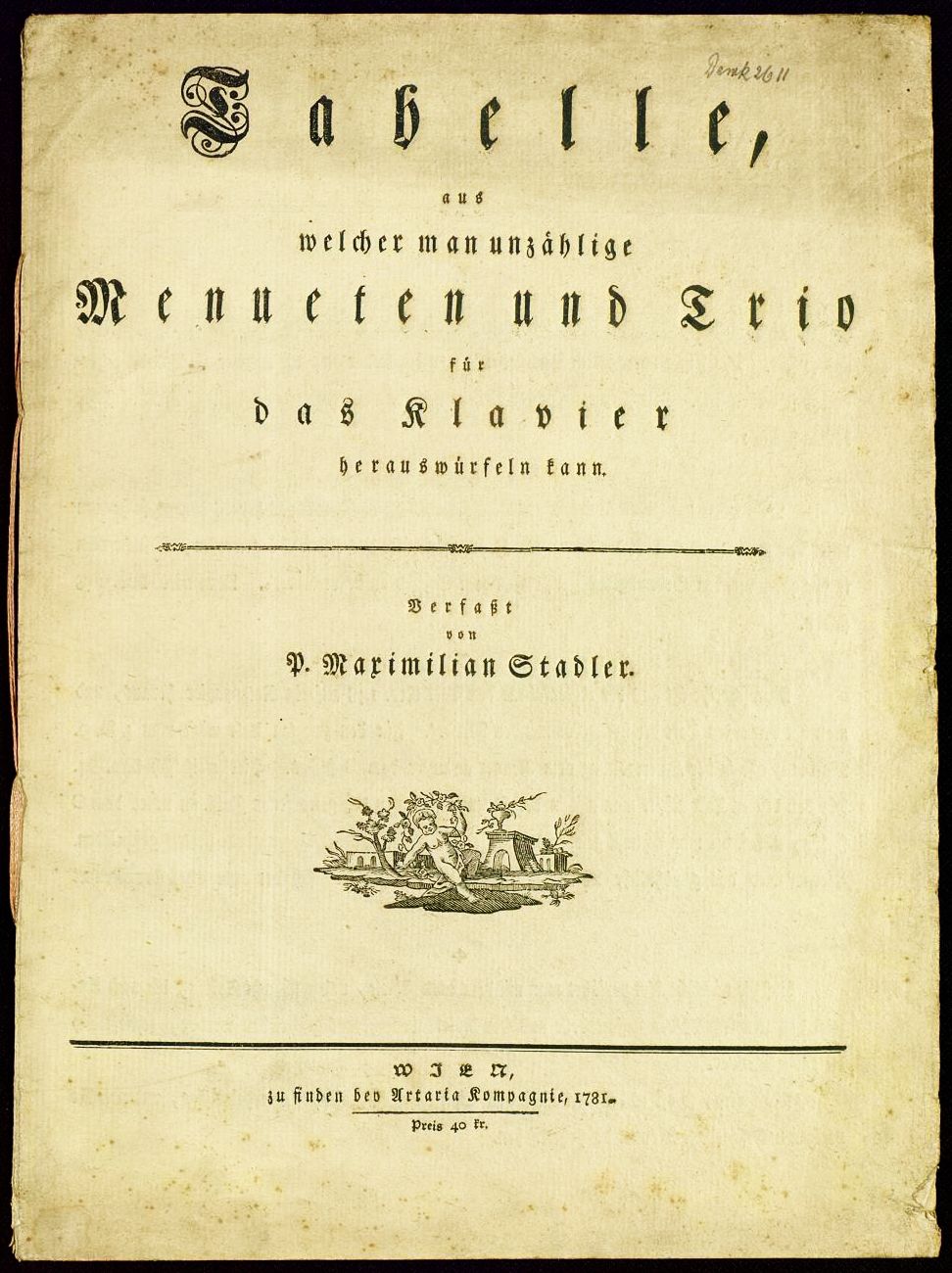
 Stadler
Stadler
Maximilian Stadler (Abbé Stadler) (1748 – 1833)

|
| The original cover for the publication "Tabelle, aus welcher man unzählige Menueten und Trio für das Klavier herauswürfeln kann". (click to enlarge) |
Stadler was an Austrian composer, musicologist and pianist. He was, in his days, not an insignificant composer and he knew Mozart, Haydn, Beethoven and Schubert personally.
His contact with Mozart was intensified after 1781 when Stadler came to live in Vienna. After Mozart’s death he rendered outstanding services to his widow Constanze by helping her to order Mozart's musical legacy. He was probably also asked by Constanze to complete some of the works that Mozart had left behind as mere fragments. (Letters from Stadler).
In his life he wrote an oratorium ("Die Befreyung von Jerusalem", 1813), multiple cantatas, songs, church music (a.o two requiems and several masses), and works for the harpsichord. He also wrote numerous essays on Mozart and was helpful in finishing Mozart's Requiem
Between 1759 and 1763 Maximilian Stadler drafted a dice game which was published in Vienna as "Tabelle, aus welcher man unzählige Menueten und Trio für das Klavier herauswürfeln kann" (Table with which one can toss countless minuets and trios with two dice) (Stadler, 1781). In 1786, this dice game was published in Paris under the title: "Table pour composer des menuets et des trios a l'infinie, avec deux dez à jouer, pour le forte -piano ou clavecin".
Stadler's game seems to have been the model for other dice games. For example, it is very similar to a dice game attributed to Joseph Haydn, published ten years later in Naples (Haydn, 1790). The only difference between the dice games of Stadler and Haydn seems to be in the key: while the Stadler dice game is in D major, the Haydn dice game is in C major (Reuter, 2013). The measure numbers table of Stadler is also identical to the table which was used by Mozart (see this program), which shows that Mozart must have been familiar with the Stadler game.
The minuet by Stadler has two parts of eight measures with 11
alternatives each (i.e. the number of different sums you can get by tossing two dice).
The trio contains two parts with eight measures each, and six alternatives per measure.
So, in total, Stadler wrote 176 + 96 measures for his musical dice game
(see: "Measures").
Stadler makes frequent use of 'long appogiature'.
To ensure a proper reproduction in sound, these have been written out fully,
taking one third of the value of the main note and anticipating the main note on the beat (Dolmetsch, 1915).
The harmonic structure in the Stadler Minuet is more variable than in the Kirnberger and Mozart dice games. Stadler uses harmonic alternatives in his game, which makes it more difficult to identify a common harmonic pattern.
Sources- Dolmetsch, The Interpretation of the Music of the XVIIth and XVIIIth centuries, London, Novello & Company, 1915, 501 pp.
- Haydn, Joseph (1790), Gioco filarmonico o sia maniera facile per comporre un infinito numero de minuetti e trio anche senza sapere il contrapunto. Napoli, Luigi Marescalchi.
- Reuter, Christoph. (2013), "Der Würfel als Autor, Würfelmusik und Zufallstexte des 17. bis 19. Jahrhunderts". In: Herbert Bannert, Elisabeth Klecker (Hgg.), Autorschaft, Konzeptionen, Transformationen, Diskussionen. Wien, Praesens Verlag. p. 195-222.
- Stadler, Maximilian (1781), Tabelle, aus welcher man unzählige Menueten und Trio für das Klavier herauswürfeln kann. Wien, Artaria Kompagnie, 12 pp. (first publication, 1780)
- Stadler, Maximilian, Letters, Bibliotheca Mozartiana, Stiftung Mozarteum, Salzburg.